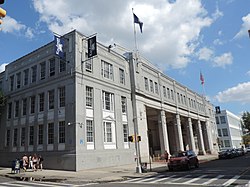Kaufman Astoria Studios
|
Paramount Studios Complex
|
|

Kaufman Astoria Studios
|
|
| Location | 35th Ave., 35th, 36th, and 37th Sts., Astoria, Queens, New York City |
|---|---|
| Coordinates | 40°45′27.74″N 73°55′25.77″W / 40.7577056°N 73.9238250°WCoordinates: 40°45′27.74″N 73°55′25.77″W / 40.7577056°N 73.9238250°W |
| Area | 5 acres (2.0 ha) |
| Built | 1921 |
| Architect | Multiple |
| NRHP Reference # | 78001897 |
| Significant dates | |
| Added to NRHP | November 14, 1978 |
| Designated NYCL | March 14, 1978 |
The Kaufman Astoria Studios is a historic movie studio located in the Astoria section of the New York City borough of Queens. It is home to New York City's only backlot, which opened in December 2013.
The studio was originally built by Famous Players-Lasky in 1920 to provide the company with a facility close to the Broadway theater district. Many features and short subjects were filmed here between 1920 and 1933. The first two Marx Brothers films were shot here, The Cocoanuts (1929) and Animal Crackers (1930), before the team moved to Los Angeles. The first Sherlock Holmes sound film, The Return of Sherlock Holmes (also 1929), was made at the studio by the British producer Basil Dean. The Dance of Life (1929) was a film musical shot on sound stages, with most exterior scenes filmed on a back lot that existed at that time. It was also known as Astoria Studio and Paramount Studio.
After Paramount Pictures moved all studio operations to California in 1932, the Astoria location was turned over to independent producers whose films were released through Paramount or other Hollywood film companies. All the films starring Tango icon Carlos Gardel made in the United States were shot at the Kaufman Astoria.
In 1942, the United States Army Signal Corps Army Pictorial Service took over the studio for the making of Army training and indoctrination films until 1971, including The Big Picture that was shown on American television as a network television series.
...
Wikipedia



